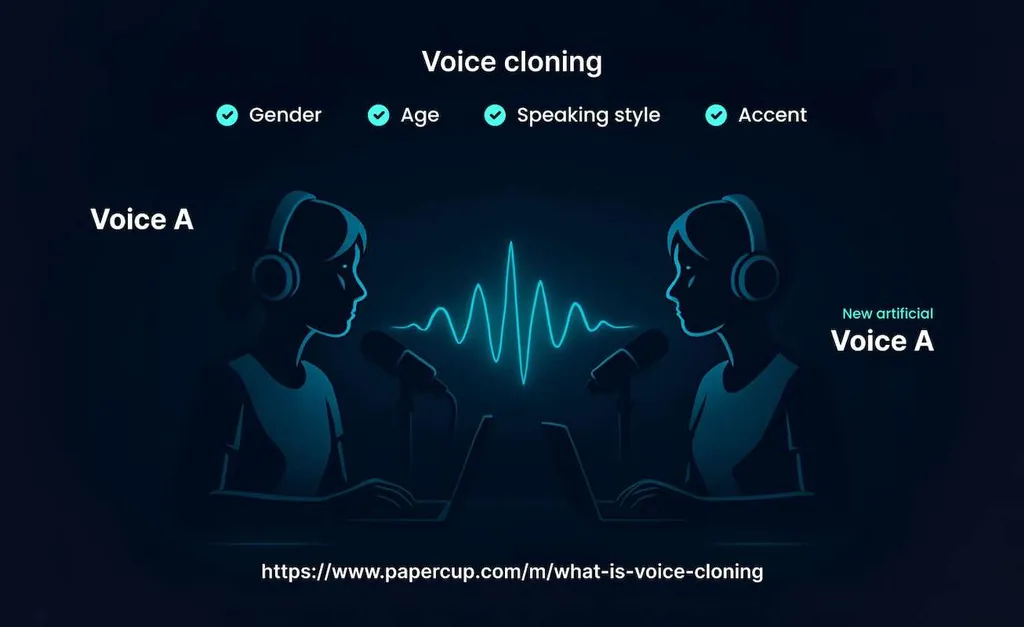Voice cloning is one of the most advanced artificial intelligence (AI) technologies. Such a tool can reproduce a person’s speech with maximum accuracy, creating a clone that may pronounce text like a real person. According to Allied Market Research, the global speech cloning industry will reach $16.2 billion by 2032. Such an AI-backed tool reproduces a person’s voice with astonishing accuracy, changing the entertainment industry, client service, and other sectors and raising ethical troubles. Below, we will analyze what is voice cloning.
Voice Cloning Explained

It is the procedure of creating a synthetic modification of a person’s voice that resembles the speech of a living person. The emergence of such a tool has become possible with the latest advances in AI, machine learning (ML), and natural language processing (NLP).
Such technology is rapidly evolving to offer more realistic speech. It is important to understand the differences between cloning and similar tools, including text-to-speech (TTS) or speech-to-text (STT). For example, TTS synthesizes lines from text, while cloning concentrates on recreating a particular person’s unique timbre.
Once cloned, the user can select any script that will be quickly read out loud by a synthetic voice utilizing text-to-speech technology. Such a tool can be utilized to voice over AI video content or even to have conversations in various languages.
The Primary Stages of Voice Cloning
If we know what is voice cloning, it is crucial to understand its primary steps. Below, we will consider a typical algorithm.
- Data collection. First, you need to get as many audio files as possible with the speech of the person you want to recreate. You will need several hours of recordings to identify each sound and intonation.
- Information processing. Special software examines databases. It breaks the file down into individual elements — phonemes — to identify key parameters, including speed, tone, etc.
- Extraction of features. After processing, the software extracts the unique features of the voice, including intonation, rhythm, and accent.
- Working with an AI-backed model. All extracted information is used to train AI-backed models. The most preferred option is a neural system. At this stage, the model is trained to reproduce certain speech properties accurately.
- Synthesis and fine-tuning. After training the model, it may create audio files with synthetic speech. Later, specialists adjust their work to sound like a human and convey the selected person’s features.
- Output Generation. The last step is to create an AI-enabled speech output generation model that allows any text to be used within the planned scope.
The effectiveness of generation depends on the correct choice of software. Read on to learn what factors to consider when choosing a reliable application.
Advantages of Synthetic Voice
Today, entrepreneurs and creative individuals increasingly use synthetic voice to solve various problems. Let’s analyze the main profits of such technology.
- Efficiency and time-saving. Creating high-quality audio content takes a lot of time and effort. The cloning system allows you to generate realistic voices in the shortest possible time. This efficiency lets you quickly complete projects and keep up with changing industry standards.
- Personalization and branding. Having a recognizable voice may increase support for your brand. Cloning technology allows you to create uniform content, ensuring a connection with the audience through familiar intonations.
- Cost reduction. Interacting with professional actors can be expensive, especially for scale projects. AI-backed speech cloning instruments create a cost-effective alternative without losing quality. Speech cloning software allows you to create professional-grade audio with minimal costs.
- Flexibility and scalability. Suppose you must generate or adapt content in different languages to various styles. You may utilize synthetic audio to scale the creation of audio files. You may clone your articulation or other speech without involving additional actors.
Users can experience all the listed benefits of synthetic speech only if they choose a reliable application for generating such content.
Use Scenarios For AI Voice Cloning

Today, this technology is used in various sectors, radically changing the interaction between businesses and their customer base and improving content production. Let’s consider several popular scenarios.
- Individualized online assistants and avatars. Speech cloning allows firms to create personal AI-backed assistants that reproduce the intonations or personality of the brand. Businesses can abandon traditional robotic responses in favor of more human software.
- Audiobook release and the media sector. Synthetic speech is changing the audiobook and video industries. Publishers no longer need to hire actors to voice each chapter. They may utilize synthetic speech to recreate a voice with a personal intonation and accent.
- Customer Engagement. Implementing synthetic voice allows firms to scale engagement with their target audience with AI-ruled audio highlighting their identity. It creates a consistent and positive impression for all clients.
- Data localization. AI-backed solutions may translate and dub videos in different languages while keeping the initial speaker’s intonation, making it accessible to a broader audience without needing re-recording.
- Growing availability. AI-backed speech generation improves the lives of patients with speech problems. Synthetic audios enable patients who have lost the ability to speak utilizing their voices rather than utilizing standard TTS solutions.
As AI, ML, and NLP instruments advance, synthetic voice will become increasingly indistinguishable from traditional conversation, expanding the technology’s scope.
The Main Challenges and Risks with Voice Cloning
As we may see, AI voice cloning suggests many benefits but has some downsides. This approach may be misused without strict controls.
- Deepfake crimes. The main problem with synthetic audio is its illegal use as an audio deepfake. Attackers may utilize the technology to impersonate others, spread false information, or manipulate someone.
- AI-backed system controls and transparency. Firms and regulation institutions must cooperate to minimize the risk of fraudulent activity. Synthetic audio must be clearly labeled, and firms must implement responsible principles.
- Consent and protection. Speech cloning should only happen after consent has been obtained. Responsible AI-backed speech generators implement advanced security systems, including virtual watermarks and identity verification, to prevent illegal activities.
In the future, experts must address several ethical issues with the technology to avoid illegal use and increase trust in digital instruments.
How to Choose a Voice Cloning Solution?
Many speech cloning apps are available today, so choosing the best option is not as easy as it seems. We recommend analyzing the following factors:
- Ease of use. Choose software with a straightforward interface that does not require long training and extensive instructions.
- Voice quality. Speech should be as clear as possible. Ensure that the application creates realistic intonations and suggests many options for adjusting the tone, intonation, and other parameters.
- Languages and accents. If interacting with people from various regions, the software should be able to work with different languages and accents. This option expands the tool’s potential and target audience.
- Multilingual support. Specialists must respond to user requests. Look for developers who offer different communication channels and fast, qualified assistance.
You must realize what is voice cloning and choose software from trusted companies, to avoid becoming a victim of scammers.
Final Words
AI voice cloning is utilized in many sectors to personalize experiences, create content and art successfully, and increase accessibility for people with disabilities. As with other advanced tools, success depends on the ability of firms that work with AI to limit abuse. Although synthetic speech changes how people create and work, professionals must address all the ethical and legal troubles. The solution will evolve when users are confident in their safety in the future.
MetaDialog focuses on text-based conversational AI rather than voice technologies, but we share the broader industry’s responsibility to promote ethical AI use. Our solutions are designed to enhance communication while prioritizing user privacy, transparency, and control, which are equally vital across all AI applications.
